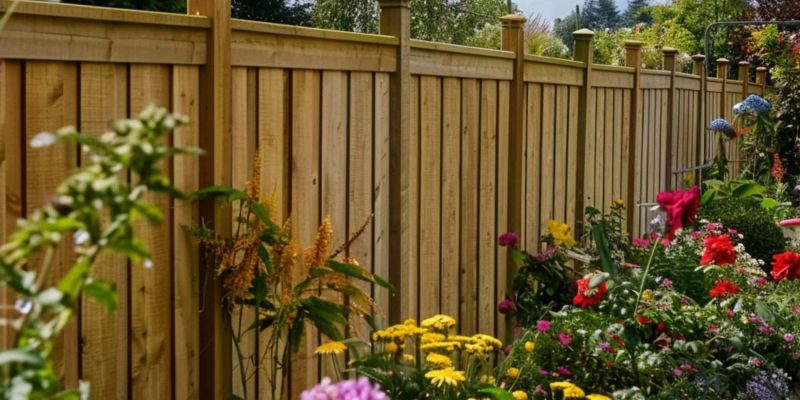Wondering if your garden fence needs a fresh coat of paint? You’re in the right spot! We’re diving into why painting your fence might be a great idea, sharing top-notch painting tips, and comparing DIY versus professional jobs. Let’s make your fence the talk of the neighborhood!
The Importance of Painting Garden Fences
Your garden fence does more than mark your property line—it’s a vital part of your home’s first impression and plays a big role in your garden’s look. Let’s talk about why giving it a splash of paint isn’t just about making it pretty:
- Aesthetic Appeal: A painted fence can transform your garden, tying together the beauty of your outdoor space with your home. Whether you pick a color that stands out or blends in, it’s all about creating a vibe you love.
- Protection and Durability: Paint isn’t just for looks; it’s like a shield for your fence. It keeps rain, sun, and even bugs from doing damage. Think of it as a way to make your fence last longer while looking good.
- Enhancing Property Value: A neat garden fence isn’t just nice to look at; it can also bump up your home’s value. It shows you take care of your place, making it more attractive to anyone who might be buying.
To Paint or Not to Paint: Making the Decision
Deciding to paint your garden fence is a bit like choosing a new outfit—it needs to fit well and look good:
Evaluating the Condition and Material of Your Fence
First off, check out your fence. Is it in good shape? Depending on what it’s made of, paint might help it last longer or just be for show. Wooden fences love a good coat of paint, while metal ones might need special care.
Considerations for Your Garden’s Aesthetic and Theme
Think about what look you’re going for in your garden. Do you want a cozy, hidden nook or a bright, welcoming space? Your fence can help create that mood, so choose colors that match your garden’s personality.
…so choose colors that match your garden’s personality.
Tips for Painting Your Garden Fence
Painting your garden fence can be a fun weekend project that spruces up your outdoor space. Here’s how to get it done right:
Preparation Is Key
Before you start, make sure your fence is ready for paint. Clean off any dirt or grime and repair any damages. If your fence is old, you might need to sand it down to get rid of peeling paint or rough spots. This helps the new paint stick better and last longer.
Choosing the Right Paint and Tools
Not all paints are the same. For outdoor fences, look for paint that’s meant for exterior use and can stand up to weather like rain and sun. When it comes to tools, a good brush, roller, or even a sprayer can make the job easier and faster. Pick one that fits the size of your fence and the detail work it needs.
DIY Painting Techniques
Start at the top and work your way down, using smooth, even strokes. If you’re using a brush or roller, dip it enough to cover but not so much that it drips. For sprayers, keep it moving to avoid too much paint in one spot.
TIP
Don’t rush; taking your time in painting your fence will make the finish look better and last longer.
Creative Ideas for Fence Painting
Why not add some personality to your fence? Try using stencils for patterns or designs, or choose a color that pops. Just remember, the goal is to complement your garden’s look, not overpower it.
DIY vs. Professional Painting: A Comparison
Thinking about painting your fence but not sure if you should tackle it yourself or call in the pros? Here’s what to consider:
Cost and Time Investment
DIY can save you money since you’re only paying for materials, not labor. But remember, your time is valuable too. If you’re busy or the job seems too big, hiring professionals might be worth the extra cost.
Quality and Durability of Outcome
Professionals have the experience and tools to get the job done right, often with a finish that might last longer than a DIY job. However, if you take your time and follow the right steps, you can achieve great results on your own.
Making the Right Choice for Your Situation
Consider the size of your fence, the complexity of the job, and your own skill level. If it’s a small fence and you’re handy, DIY might be just fine. But for big projects or if you want a guarantee of quality, professional painters are the way to go.
Common Issues and Questions
When it comes to painting garden fences, here are some of the most common questions and issues people run into:
Frequently Asked Questions
- When is the best time of year to paint? Aim for dry, mild weather—not too hot or cold.
- How often should I repaint my fence? It depends on the paint and your fence material, but generally every 2 to 5 years.
- How do I choose a paint color? Consider your garden’s style and your home’s exterior. Neutrals are safe, but don’t be afraid of color!
Troubleshooting Common Painting Problems
- Paint drips and runs: Use less paint on your brush or roller and apply with even strokes.
- Uneven coverage: Apply a second coat of paint for a more uniform finish.
- Peeling paint: Make sure the fence is clean and properly prepped before painting. Peeling usually happens when paint is applied over dirt or old, flaking paint.
Maintenance and Care of Painted Fences
To keep your painted fence looking its best year after year, regular maintenance is key. This includes gently washing it to remove dirt and debris, which can lead to wear and tear over time. Inspect your fence periodically for any signs of chipping, peeling, or fading paint, and touch up these areas promptly to prevent further damage.
Additionally, consider applying a sealant every few years to enhance the paint’s durability and extend the life of your fence. Remember, a well-maintained fence not only boosts your home’s curb appeal but also serves as a sturdy boundary for your garden.
Environmental Considerations
When painting your garden fence, choosing environmentally friendly paints is a thoughtful way to protect your garden’s ecosystem. These paints minimize the release of harmful chemicals into your garden, providing a safer environment for plants, pets, and wildlife.
Also, consider the color of your paint carefully; lighter shades reflect sunlight, potentially keeping your garden cooler, while darker colors absorb heat which can affect sensitive plants near the fence. By being mindful of these factors, you can make decisions that are both aesthetically pleasing and kind to the environment.
Enhancing Your Garden’s Privacy and Security
A well-painted and maintained garden fence doesn’t just add to your home’s beauty; it can also significantly enhance your garden’s privacy and security. Choosing the right height and paint opacity can deter prying eyes without making your garden feel enclosed.
For added privacy, consider using paints that provide a solid finish or incorporating design elements like latticework at the top, which adds style while increasing coverage. Additionally, a sturdy, well-painted fence can act as a first line of defense against unwanted visitors, like an animal and humans, keeping your garden safe and secure.
Conclusion
Painting your garden fence can be more than just a cosmetic touch-up; it’s an investment in your home’s curb appeal, protection, and overall value. Whether you decide to DIY or hire professionals, taking the time to do it right can transform your outdoor space. So, grab that paintbrush (or phone book) and give your garden fence the love it deserves!

